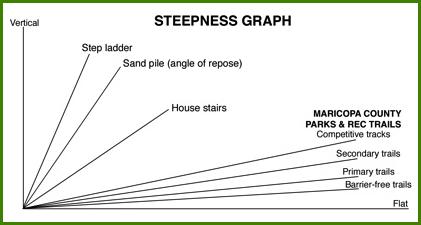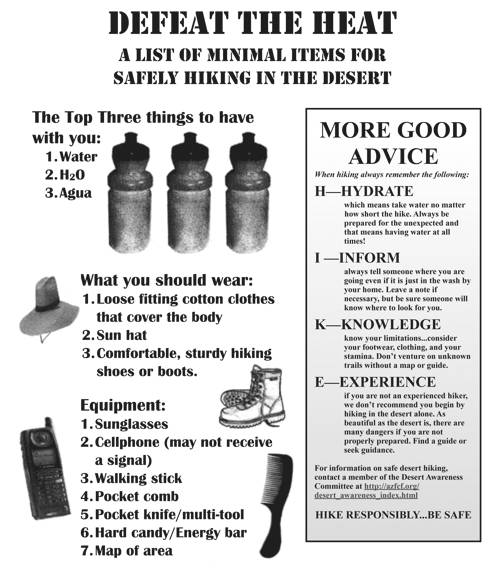BY JIM BLACKBURN | MARCH 9, 2011
 Just how steep is that trail?
Just how steep is that trail?
A geometry primer applied to hiking
When you’re winded hiking uphill, it’s steep.
When you’re slipping downhill, it’s steep-steep.
When you’re easing down sideways, it’s steep-steep-steep.
When sliding down on your butt, it’s steep-steep-steep-steep.
Steep. “Steep” … it’s not too definitive, so I decided to make the graph shown below to visualize and quantify different grades. Grades are often measured by how high up you go as you progress horizontally. For example, a wheelchair-navigable trail is no more than a five-foot rise in one hundred feet horizontally. This is called a 5 percent grade (i.e., five divided by 100).
I-17 north of Phoenix has signs every so often proclaiming 6 percent grades, i.e., 6 feet up or down for 100 feet horizontal progress (shift to lower gear). Just a bit steeper than a wheelchair-navigable trail.
Of course, four-wheel drive vehicles with their lower gearing and deep tire treads can climb much steeper hills and grades. I know. I often slip when hiking the steepest jeep trails in the foothills.
 What is a steep uphill trail? I’ve hiked along the ridge trail of the Cave Creek side of Black Mountain several times and have looked up its change in elevation versus distance on a topographical map. Only 15 percent average! Seems steeper when stepping and crawling over the rocks. (My hiking partner, Pete, tells me there’s an old saying, “Just over this crest ahead there’s another.”)
What is a steep uphill trail? I’ve hiked along the ridge trail of the Cave Creek side of Black Mountain several times and have looked up its change in elevation versus distance on a topographical map. Only 15 percent average! Seems steeper when stepping and crawling over the rocks. (My hiking partner, Pete, tells me there’s an old saying, “Just over this crest ahead there’s another.”)
By comparison, the grade of typical stairs in a house is 60 percent. How about a stepladder? 260 percent. And then there’s the fire escape down a wall or a vertical rope!
Going a bit further, just how steep is a pile of sand such as is dumped from a truck? About 70 percent. (It depends on the material and if it’s wet.) The steepness of such a slope is referred to as the Angle of Repose. As our mountains wear down, the loose rocks, talus slopes, and sand dunes slide down to this Angle of Repose and we’ll likewise slide down as well.
Maricopa County Parks and Recreation Department has an elaborate set of standards and specifications for our trails. See the graph and table. Note the barrier-free trails are wheelchair navigable. Their interpretive trails are also wheelchair navigable, usually with a 5 percent grade.
It was amazing to me how such a little difference in grade made such a big difference in my climbing (and descending) efforts. Notice the difference in angle between a primary trail and a secondary trail. It’s just 5 percent, but when hiking it seems to make a whale of a difference.
 If the hill is steeper than these specifications, then switchbacks are implemented. The abrupt back-and-forth winding of the Squaw Peak trail is a good example of switchbacks.
If the hill is steeper than these specifications, then switchbacks are implemented. The abrupt back-and-forth winding of the Squaw Peak trail is a good example of switchbacks.
The grades are summarized in the table on the next page, but the angles shown in the graph are more revealing. What seemed to be steep to me on the trail just doesn’t look that steep on the graph. Only appears like “a little” uphill!
Cleated hiking shoes are recommended on our trails. Tennis shoes are great up and down on firm footing like concrete or paved roads, but on loose gravel they are prone to slip. Tennis and walking shoes are very comfortable, but their tread just doesn’t catch very well on a loose granite slope. My old Vibram lug soles do a much better job gripping. Edges dig in when sidestepping down and the soles are less flexible over rocky trails.
A walking stick can be a great help offering brace and balance on steep grades. It’s also a great aid when rock-hopping across a creek/stream.
Now you know that a steep trail is only about a 15 percent grade and a steep-steep-steep-steep trail is approximately 60 percent or so. Seems steeper than easing down the house stairs on your butt – Angle of Repose. Incidentally, I like going up better than down.




